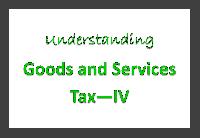
GST as a nationwide commodity and services tax system requires sound supporting infrastructure on several fronts. Actually, under GST, tens of thousands of tax payers -business entities and service providers interfaces with tax administration. The engagement will be hectic as the business entities and service providers have to make monthly updation of their business invoices and tax returns into the web portal prepared for the GST.
Because of this big task in front, the government has built the required facilitating arrangements for the new tax system, prominently on the following fronts:
(a) Legal – the Constitutional Amendment Act 101
(b) Institutional – the GST Council
(c) Information Technology – GSTN
(a) Legal support for GST
Everything starts with the Constitutional amendment that paves the way for further action. The GST as an economic reform has been a constitutionally built mechanism. Remind that tax powers of the Centre and states are regulated by constitutional provisions. This means that the taxes to be levied and collected by the two types of governments is well specified in the constitution. Restructuring that allocation by merging the taxes of the Center and states for the creation of GST need constitutional amendment.
For creating the legislation, Center and the states have to reach on consensus of numerous issues. Aa a result of a decade long negotiations, several issues were sorted and the Government has introduced One Hundred and Twenty-Second Amendment Bill, in 2014. When the Parliament passed it on 6 May 2015, it became the 101st Constitutional Amendment Act. (Several Constitutional Amendment Bills remains not passed and that is why the 122nd amendment Bill became the 101st Amendment Act). A Constitution Amendment Bill like the GST Bill needs to be ratified by the legislative assemblies of at least 50 per cent of the 29 states and 2 union territories. The required number of states ratified the Bill.
The Constitutional Amendment Act 101 has created new articles, amended some existing articles and deleted few. Sixth and Seventh Schedules of the Constitution were also amended. One of the important amendment was the creation of GST Council after Article 279 A.
(b) Institutional Mechanism – the GST Council
Most systemic changes need the support from dedicated institutions; and if the change is big, we have to create fresh institutions. In the case of GST, the responsibilities were tremendous as the Centre and the States have to reach consensus on ceding their taxation power to create a common tax for goods and services. Finance Minister Arun Jaitely at the inauguration of GST described it as an outcome of political coordination. To realize the coordination process, the Constitutional Amendment 101 created the GST Council after Article 279A. The GST Council comprises of the representatives of Centre and States. Voting pattern in the GST Council was also unique. Following are the members of GST Council.
- Union Finance Minister
- The Union Minister of State, in-charge of Revenue of finance… Member
- The Minister In-charge of finance or taxation
- State Finance Ministers
- Two representatives from UTs
The GST council will be chaired by the Union finance minister. A state finance minister will be deputy chairman.
Voting under the GST Council
The Centre will have one-third vote. All states together will have a two-third. To adopt a resolution, three-fourth majority would be required. This will make a near-consensus between the centre and the states an imperative for any major decision.
Functions of the GST Council
- The council will have the last say in finalizing the shape of the GST.
- It will finalize the tax rate under the GST as well as the revenue threshold for traders to be exempt from this tax.
- It will prepare the model Central, State and Integrated GST laws.
- It will make recommendations on the taxes, cesses and surcharges that will be subsumed by the GST.
- It will also decide if and when petroleum and petroleum products will come under the GST’s ambit.
- The council will also decide which goods and services will be exempt from the tax to protect the common man as well as the fine print of the sharing of administrative duties between the central board of excise and customs and the state tax officers.
- The council will also have the final say on the mechanism to resolve disputes that may arise between the centre and the states or between states.
(c) IT Infrastructure – the GSTN
The work-horse entity that was created to function as a digital platform for administering the tax transactions by tens of thousands of business entities is the Goods and Services Tax Network (GSTN).
The Goods and Services Tax Network (GSTN) is a non-government non-profit private limited company created for providing the front end and back end IT and infrastructural support for the working of GST. It is registered as a non – profit Company under the New Companies Act in March 2013. Following are the main functions of GSTN:
(i) facilitating registration;
(ii) filing of returns and forwarding the returns to Central and State tax authorities;
(iii) computation and settlement of IGST;
(iv) matching of tax payment details with banking network;
(v) providing various Management Information System reports to the Central and the State Governments based on the tax payer return information;
(vi) analysis of tax payers’ profile; and
(vii) running the matching engine for input tax credit
As a non-government the Governments –Centre, states plus UTs hold 49% of GSTN. Central government holds 24.5% while the remaining governmental share of 24.5% is held by sub-national governments (states and UTs). The remaining 51% share is divided among five financial institutions—LIC Housing Finance with 11% stake and ICICI Bank, HDFC, HDFC Bank and NSE Strategic Investment Corporation Ltd with 10% stake each.
Private sector IT vendors will develop the web or mobile base interfaces for taxpayers to interact with the GST network. They will be called as GST Suvidha Providers.
*********









